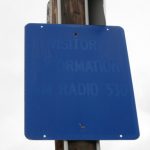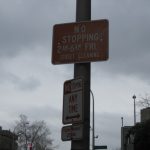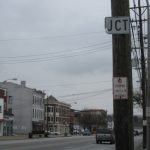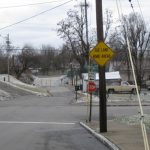
[ Editor’s Note: Thanks again to guest contributor SushiK for putting together this look at street signs across Louisville showcasing the many tiny problems that can add up to information overload in our environment. ]
Sign Sign everywhere a sign
Blocking out the scenery breaking my mind
Do this, don’t do that, can’t you read the sign
As a person who gets around primarily by foot and bicycle, I am very aware of the nuances of my physical environment. Traveling more slowly than I would by automobile or bus, I am more likely to notice the little details of the streetscape, such as signs. I have recently begun to focus my attention on the large numbers of signs on our streets, and how interesting they can be. Many signs have piqued my curiosity because they are puzzling, redundant, or ill-placed, and I find myself wondering about their history as well as their effectiveness as transmitters of information.
I am not an engineer, but I hang out with a few, and I know a bit about the policies that govern which signs are used and where they are placed. The recently-updated Manual on Uniform Traffic Control Devices (MUTCD), developed by the Federal Highways Administration (FHWA) has a dizzying amount of information about signs. The Manual has an unnervingly orderly view of the streetscape which is frequently not reflected in the crazy chaos of the real world.
As I have begun to notice signs more, I have had a lot of questions. One of the top ones is: if I can barely process all these signs when walking and bicycling, do people in motor vehicles see them?
Well-known authority on bicycle and pedestrian issues Dan Burden, when speaking at last year’s Louisville Bike Summit II, stated that signs don’t help correct problematic traffic situations; they just make us feel better about them. If that is true, then judging by the sheer numbers of signs on our streets, we should feel pretty good.
What do Broken Sidewalk readers think about signs? Do you have ones you particularly like or dislike? Do you think signs are an effective way to communicate information to street users?














The handmade sign is a dozen years old or so. Youth from the neighborhood, grown and having moved away now, used the homemade sign as the backboard for a basketball goal. The rim, after months of being slam-dunked upon, is long gone.
The Blockwatch sign — still fairly accurate as there are neighbors who keep their eyes pealed and call Metro Police.
Great discussion and documentation on excessive signage, which has bugged me for a while too.
I think all these signs are a) ugly detriments to a prettier, more unclutter city, b) obvious reminders of a lack of maintenance and attention paid to some infrastructure, and c) redundant, ignored, or quite possibly ineffective even if heeded.
A sort of “tree falling in the middle of a forest” thing. With everyone talking, texting, etc, not enough attention is paid to keeping cars somewhat under control much less the particulars of all these signs.
Tarc is just as bad too with their signs I think:
http://www.flickr.com/photos/crankedmag/4244640625/
And now Toyota drivers may not be capable of heeding ‘STOP’ signs, even if they intended to. Geez.
Louisville’s visual clutter is nothing new and seems to be a good indicator of the disorder in how “planning” plays out….
Is that the Leprechaun in that last sign? Has it moved to Louisville?!?!
http://www.youtube.com/watch?v=nda_OSWeyn8
We still need Ladybird.